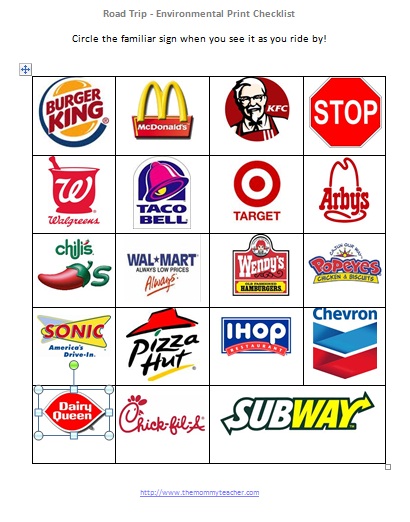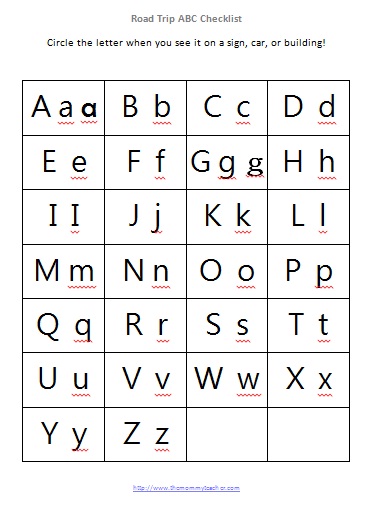As promised, in the post “Pack Your Clipboard” here are more checklists, and they are perfect for the Car:
Complete A Story, Letter, or Poem
When I was little I loved mad libs because creative writing was a favorite past time of mine and madlibs allowed me to play around with silly writing topics and ideas that were fun to read to others. They were great for learning parts of speech as well.
But today, I want to encourage you to get your little one to “write” stories, letters, or poems by filling in the blanks of incomplete sentences in their own way.
My sister shared the following poem that my brother completed years ago before mad libs even existed. It is different from a mad lib because you don’t choose the words beforehand; you fill in the blanks of incomplete thoughts which is more age appropriate for little ones.
Here are a couple Fun with writing templates for you; made by me:
Christmas Tree Counting Printable
I can’t wait to share my activity ideas and schedule that I am setting up for my little one, as well as another great giveaway on the way!
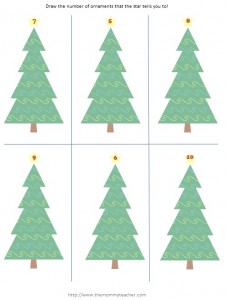 In the meantime, here is a freebie that I made for your little one to practice drawing sets of objects. Don’t just hand your little one a set of crayons/markers and say “get busy.”
In the meantime, here is a freebie that I made for your little one to practice drawing sets of objects. Don’t just hand your little one a set of crayons/markers and say “get busy.”
First, lay the Christmas Tree Counting Printable on the table with something small and colorful (like skittles) that you and your little one can use to practice counting sets together.
Then, point to one of the trees and show your little one how you might “decorate the tree.” “Ooh, this tree has the number nine on the star, I’m going to decorate the tree with nine colorful skittles! One, two, three, four, …..etc.”
This is a great way to model the directions by showing your little one how to recognize the number and count out that given quantity, AND by modeling one-to-one correspondence (counting one object per given number).
After you have your little one complete the hands-on round of the printable, on their own (assisting and prompting where necessary), then explain that instead of skittles, this time they will draw the number of ornaments (circles, candy canes, snowflakes, or whatever shape he/she wants). Before they begin, model an example of how to do this on a separate sheet of paper. And that’s it; now you have purposefully used a printable 🙂
October Calendar!
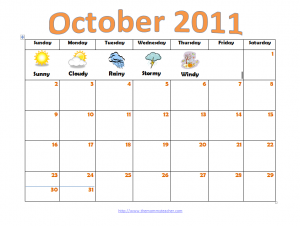 Are we already a week into the month of October? Believe it or not, I am just now making and printing my October Calendar to post in my kitchen. So, go back and read my September Post about Weather Tracking for some of my thoughts on teachable opportunities with Weather Tracking and try to start October’s tracking (a little late thanks to yours truly).
Are we already a week into the month of October? Believe it or not, I am just now making and printing my October Calendar to post in my kitchen. So, go back and read my September Post about Weather Tracking for some of my thoughts on teachable opportunities with Weather Tracking and try to start October’s tracking (a little late thanks to yours truly).
Here is your October Calendar
If you would like to buy the entire year of this theme, check them out HERE!
Real or Make-Believe Stories
Little ones have the BEST imaginations; yet, some things that we define as make-believe may seem like a real possibility in a child’s creative little mind.
Still, it is important to start having “real” versus “make-believe” conversations with our little ones…..PLEASE don’t take this post out of context and start breaking their hearts about different heroes they may have that may or may not exist 😉
I am talking about asking questions about books and stories like “Goldilocks and the Three Bears”….
Asking questions like: “Could that really happen in real life? Can animals talk? Do bears live in cabins in the forest and act like people?” Etc.
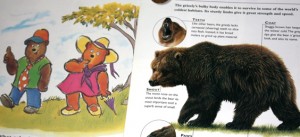 IF your little one says “yes” say “hmmmm….I wonder if we could observe bears in the real habitat/home they live in to see how they really are.” Go to youtube.com and search for different real-life bear videos to show your little ones the reality THEN ask questions like: “What are some things that are the same? What are some things that are different?”
IF your little one says “yes” say “hmmmm….I wonder if we could observe bears in the real habitat/home they live in to see how they really are.” Go to youtube.com and search for different real-life bear videos to show your little ones the reality THEN ask questions like: “What are some things that are the same? What are some things that are different?”
A great way to make a measurable chart contrasting real and make-believe is to
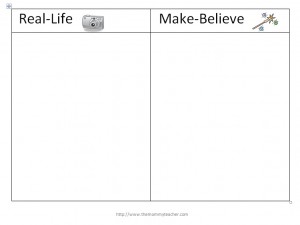 1) Print the freebie I made for you: Real vs make-believe printable (You could also make/use a venn diagram)
1) Print the freebie I made for you: Real vs make-believe printable (You could also make/use a venn diagram)
2) Cut out pictures from magazines and place them in the column under the category it falls into.
3) Talk about it….ask questions to get your little one to figure it out logically!
This teaches your little one critical thinking skills, introduces the concept of fiction vs. nonfiction, and allows your little one the opportunity to build on oral vocabulary and express their ideas about their observations.

